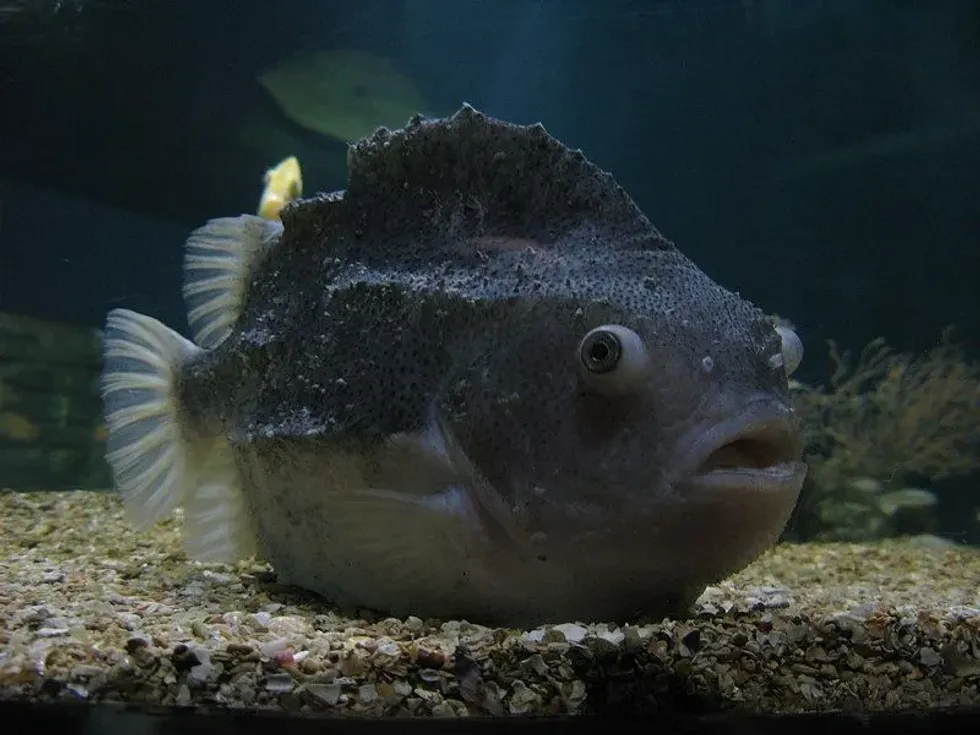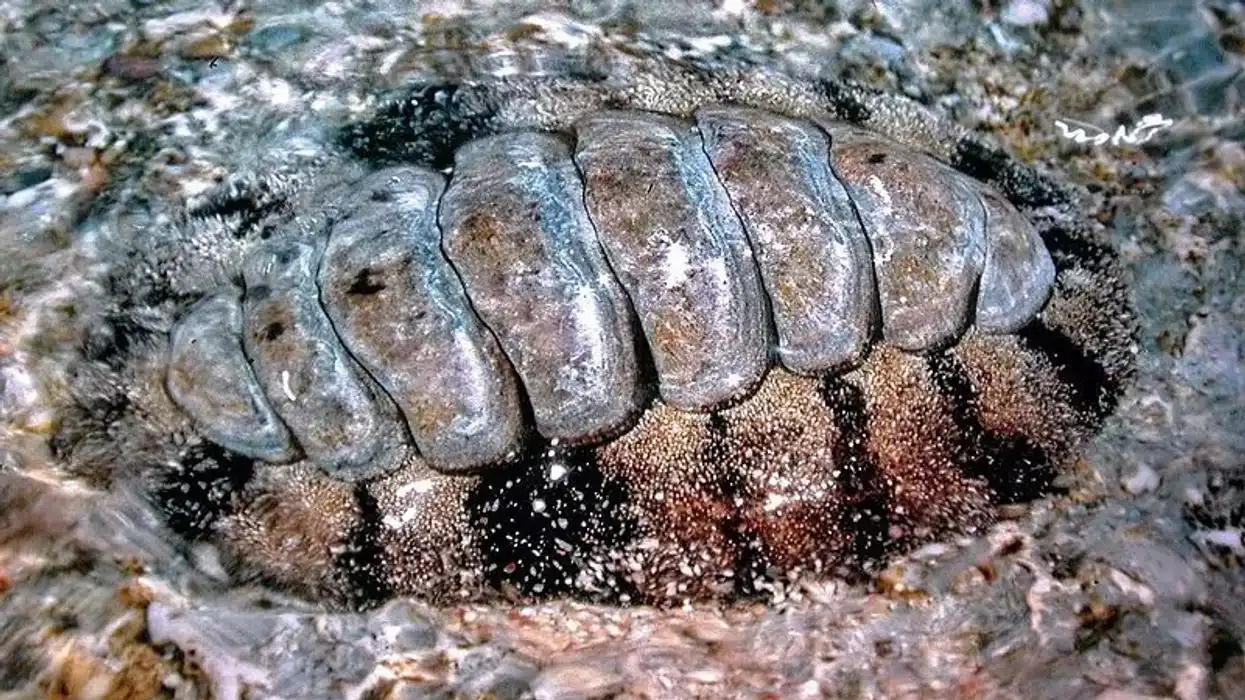The lumpfish is a type of migratory fish found living in the Pelagic zones between the ocean floor and the shallow beaches. They are migratory fishes and travel long distances for spawning and feeding. They also migrate from place to place during day and night.
Generally, they prefer shallower waters at night and the seabed during the day. These fishes are considered to be symbiotic. Their main meal consists of parasites and lice.
They live near rocky regions, sometimes along the coast, and nibble off the substrate from its surface. They are also known to eat parasites off other fishes like salmon. This makes them an ideal 'pesticide' for farmers who harvest salmons.
Lumpfish are also known as lumpsuckers. This is because of a ventrally located suction disc near their pelvic fins. The disc helps them to suck or stick on to surfaces.
Their main predators include seals, sperm whales, and sharks. The eggs of these fish, known as caviar, are widely eaten as a delicacy.
However, lumpfish caviar is considered to be one of the cheaper or less flavored brands of caviar. While lumpsuckers are found in various bright and dull colors, they also happen to change colors depending on their stage of maturity.
It is one of the species in which the female is larger in size than the male lumpfish. Thus, keep on reading for more information about the lumpfish.
To know more about similar fishes, check out yellowfin tuna and catfish.
Lumpfish Interesting Facts
What type of animal is a lumpfish?
The lumpfish, also known as lumpsucker, is a type of marine fish.
What class of animal does a lumpfish belong to?
A lumpsucker belongs to the class of Actinopterygii, which includes ray-finned and bony fishes like parrotfish and puffers.
How many lumpfish are there in the world?
There is no estimate regarding the total number of lumpfishes worldwide.
Where does a lumpfish live?
An ideal habitat for the marine lumpsucker would be the cold waters of the Pacific and Northern Atlantic Ocean. They reside in the pelagic zones of the ocean and subside to the sandy bottom during the day.
Generally, they are found around muddy or rocky substrates where they feast on infected or dying fish, lice, fish eggs, small crustaceans, and other parasites.
What is a lumpfish's habitat?
The lumpfish is a migratory fish. Hence, their location changes during their life. These fishes generally hatch in marine tidal pools, where the eggs are laid.
After a few weeks, they migrate to the pelagic zones where they feed and grow. During the breeding season, they return towards the coast and lay eggs in tidal pools. The male of the species makes its way first to prepare a nest for the female.
Who do lumpfish live with?
Little is known about the behavior of lumpfishes in the wild. It is known that they are mostly solitary but non-aggressive creatures.
They only look for partners during the mating season. Male fishes spend the spawning time incubating and taking care of young ones. Once this is one, the males return to their solitary lifestyle in the pelagic zone again.
How long does a lumpfish live?
The average life span of a lumpfish is seven to eight years. Sometimes, they have been seen to live for as long as thirteen years as well.
How do they reproduce?
Lumpfishes are sexually dimorphic, which means the female is larger in size than the male. The male takes care of the children. The spawning or the mating season is during spring.
It is the only time that the solitary lumpfish looks for a partner. After mating, the male heads towards the tidal pools near the coast to create a nest in the rocky bed. The female visits later and lay eggs in batches ranging from 5,000 to as many as 350,000.
This occurs over a period of a couple of weeks. The female departs after laying eggs.
The male takes care of the eggs, incubates them and waits for spawning. The lumpfish Cyclopterus lumpus, once born, may travel back to the pelagic zones after a few weeks. Usually, females return to the same place to lay eggs.
What is their conservation status?
There is not really enough data to predict the conservation status of lumpfish. There are 140 different species of lumpfishes.
Only the lumpfish (Cyclopterus lumpus) is threatened by humans directly as these are considered a delicacy in a few countries like Japan and China, plus in Scandinavian countries. Smaller fishes can easily escape from fishing nets. Water pollution near the coast is also a major cause of concern to their habitat and can lead to their decline.
However, lumpfishes are also bred in captivity. In Norway alone, around 31 million lumpsuckers are used in fish harvesting to clean the waters and reduce fish infestation.
Lumpfish Fun Facts
What do lumpfish look like?
A lumpfish can be immediately distinguished by its reddish or bluish color and lumpy appearance. Their shape is rounded, with large pairs of eyes on either side of their head. Their skin is thick, and they possess a distinct circular pectoral fin.
Their lumpiness comes from a layer of jelly-like fat located beneath the skin. While they are bluish or greyish in color, the smooth male lumpfish will turn reddish during the mating season. Females remain the same color throughout.
How cute are they?
Lumpsuckers are quite cute and adorable creatures with their bright colors and short, rounded fins. The balloon lumpfish from the North Atlantic is quite alluring with its rounded shape and small eyes. Their bright colors make them look similar to party balloons. In a lumpfish aquarium, they are often trained to remove skin scrapes.
How do they communicate?
Lumpsuckers are solitary creatures and spend their day quietly foraging for food. When threatened, they may ward off predators by splaying their bony fins. The pointy bones help to attack predators and also differentiate them.
How big is a lumpfish?
Lengthwise, a lumpfish can grow as much as two feet. They are similar in length to a salmon and around half the size of a parrotfish. In the Baltic Ocean, however, lumpfishes do not grow more than 7-8 inches in length because of the highly salty water.
How fast can a lumpfish swim?
They are slow horizontal swimmers because of their round, lumpy shape. However, they can quickly adapt to vertical changes.
How much does a lumpfish weigh?
On average, lumpfishes from the North Atlantic weigh around 11 lb (5kg). Females are larger in size and may weigh as much as 11 lb or 9.6 kg.
What are their male and female names of the species?
Both males and females are known as lumpfish or lumpsuckers.
What would you call a baby lumpfish?
Lumpfish babies are known as larvas.
What do they eat?
The lumpfish feasts on fish parasites, zooplankton, small crustaceans, mollusks, and worms. Sometimes, they eat jellyfishes. They feed on dying fishes and lice stuck on tricky surfaces. They are nibblers and are useful in keeping aquariums clean.
Are they eaten by humans?
Lumpfish Cyclopterus lumpus is eaten as a delicacy in some places. As caviar, their eggs are eaten worldwide.
Black lumpfish caviar is an excellent dish for treating calcium deficiency. Caviar refers to fully-ripened lumpfish eggs. These are generally pinkish-red or black in color.
Also known as lumpfish roe, these are excellent sources of omega-3. Due to its less favorable taste, lumpfish roe is much cheaper than that of other fishes like scallops, salmon, and squids.
It is also less salty than salmon caviar and is eaten both as a side dish and garnish. Lumpfish roe may be collected after it has been laid or directly obtained from a caught female lumpfish. In Iceland, the male lumpfish is often consumed smoked and boiled.
Previously, the female fish was discarded after the lumpfish roe was obtained. But now, it is mandatory to freeze the body (if the lumpfish roe is obtained from a live fish).
Would they make a good pet?
A lumpfish pet will be a friendly and non-aggressive addition to one's family. However, lumpfish prefer to live in the cold waters of the North Atlantic. Hence, one will have to invest heavily to get the proper tank equipment to keep it below room temperature. They are good cleaner fish and will keep the aquarium free from plankton.
Did you know...
Interestingly, lumpsuckers lack a swim bladder. Swim bladders help fishes move to deeper or shallower waters by holding or releasing air.
With the lack of a swim bladder, lumpfish can move vertically using their strong fins and cartilages. They can change their vertical position as much as 300 m within a day, which means quite a huge difference in atmospheric pressure to adjust to!
The absence of a bladder and also the suction disc earlier led scientists to believe that they are seldom-moving bottom-dwelling fish.
Lumpfishes generally have designated shelters within the rocky substrates. They hide in these caves from predators.
Usually, it is the male lumpfish that is fished and eaten throughout the year. The only exception is during the spawning season ranging from March to August when females are specifically eaten.
Do lumpfish have scales?
The body of a lumpfish is fleshy and not covered with scales. However, they have seven distinct ridges running along their body which contain pointed tubercles, these help in defense, attracting females and separating one species from another.
Are lumpfish good swimmers?
A lumpfish swimming in a fast current is a poor sight to watch. They are very poor with respect to aerobics, and their main ability comes from their suction to surfaces during strong currents.
Their rounded body is not designed for heavy swimming, unlike other streamlined fish forms. While they are migratory, they are good swimmers only within a specific current range.
Here at Kidadl, we have carefully created lots of interesting family-friendly animal facts for everyone to discover! Learn more about some other fish including porcupine fish, or milkfish.
You can even occupy yourself at home by drawing one on our lumpfish coloring pages.










